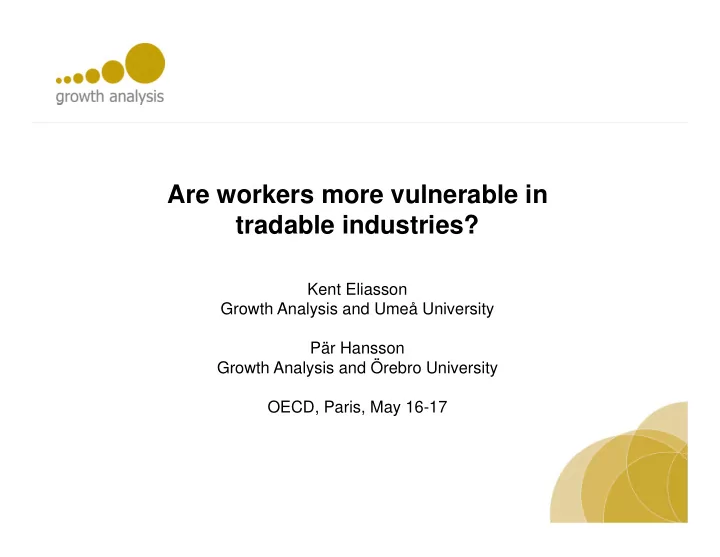

Are workers more vulnerable in tradable industries? Kent Eliasson Growth Analysis and Umeå University Growth Analysis and Umeå University Pär Hansson Growth Analysis and Örebro University OECD, Paris, May 16-17
Background and aim of the paper • Growing international trade in services Growing international trade in services • Painful consequences for a growing amount of displaced workers in the service sector (Blinder, 2006) • Compare the displacement costs of workers in tradable services, manufacturing, and non-tradable services g, • Draws on Jensen and Kletzer (2006, 2008) who based on DWS presents descriptive evidence for the United States • We develop their approach and use a regression framework to examine the costs of displacement in tradable and non-tradable sectors of the economy
Identification of tradable services The problem The problem • Data on international trade in services less developed than trade in merchandise • Which industries in the service sector are exposed to international trade? The solution • The degree of geographical concentration of industries indicates domestic trade and potential international trade (Jensen and Kletzer, 2006) • We calculate locational Ginis based on 3-digit NACE (172 industries) and functional labor market regions (72) • Locational Ginis in manufacturing industries are used as a benchmark to identify service industries where international trade might exist
Employment shares of manufacturing, tradable and non tradable services, 1990 2010 and non-tradable services 1990-2010 70 60 Manufacturing 50 Tradable service 40 % Non ‐ tradable Non tradable 30 service 20 10 0 0 1990 1995 2000 2005 2010
Definition of displacement • Linked employer-employee data based on administrative registers kept by Statistics Sweden • Follow definition recommended by OECD • Based on the units of establishments, rather than firms • Establishments more stable unit, tractable over time in administrative registers
Displacement rates by sectors, 2000-2009 7 6 5 4 % 3 2 1 1 0 2000 2001 2002 2003 2004 2005 2006 2007 2008 2009 Manufacturing Manufacturing Tradable services Tradable services Non tradable services Non-tradable services
Econometric analysis of displacement costs 1. Probability of displacement 2. Probability of re-employment Data for 2000-2009. 10 % random sample fulfilling base sample restrictions. Pooled sample with 2.1 million individuals. 49,000 (2.3%) classified as displaced in year t . 43,000 (88%) re-employed in year t . 3. The effect of displacement on earnings 3. The effect of displacement on earnings Data for 2000-2005. 10 % random sample fulfilling base sample restrictions. Pooled sample with 885,000 individuals observed during a ten year period t -5 to t +4. 25,000 (2.8%) in the treatment group (displaced in year t ) and t 5 t t 4 25 000 (2 8%) i th t t t (di l d i t ) d 860,000 in the comparison group (not displaced in year t ) JLS (1993) fixed-effects specification ( ) p Dependent variable: Real gross annual earnings (including zero) Effect in percent using average earnings of displaced in year t -1 as a baseline
Proportions of displaced workers by characteristics in different sectors, 2009 , Tradable Non-tradable Manufacturing services services Level of education at t-1 Less than secondary 0.17 0.07 0.14 Secondary 0.65 0.45 0.60 Post-secondary 0.18 0.48 0.25 Establishment size at t-1 10-49 0.35 0.50 0.60 50-99 0.19 0.16 0.20 100-199 0.15 0.13 0.11 200-499 0.16 0.18 0.06 500+ 0.15 0.02 0.03 Region of residence at t-1 STOCKHOLM STOCKHOLM 0 06 0.06 0.39 0 39 0 27 0.27 ÖSTRA MELLANSVERIGE 0.16 0.13 0.16 SMÅLAND MED ÖARNA 0.16 0.05 0.06 SYDSVERIGE 0.11 0.13 0.14 VÄSTSVERIGE 0.27 0.17 0.22 NORRA MELLANSVERIGE 0.12 0.05 0.08 MELLERSTA NORRLAND 0.04 0.05 0.04 ÖVRE NORRLAND 0.07 0.03 0.04
Probit estimates of displacement and re-employment p y Di Displacement l t R Re-employment l t Sector t-1 Manufacturing + - Tradable services + + Individual characteristics t-1 Age - + Age squared Age squared + + - - Male + + Level of education - + Establishment characteristics t-1 Private + + Size - + Regional characteristics t-1 STOCKHOLM + +
Effect of displacement on annual earnings by sector g y 2 0 t-3 t-2 t-1 t t+1 t+2 t+3 t+4 -2 -4 % -6 6 -8 -10 -12 Manufacturing Tradable services Non-tradable services
Concluding remarks • • The probability of displacement is higher in the tradable sectors The probability of displacement is higher in the tradable sectors, particularly in tradable services • The prospect of re-employment are most promising for workers displaced from tradable services and least encouraging for workers displaced from manufacturing • The relatively low probability of re-employment for workers displaced The relatively low probability of re employment for workers displaced from manufacturing translates into the highest earnings losses during and following displacement for these workers • Despite promising re-employment opportunities, workers displaced D i i i l i i k di l d from tradable services suffer fairly high earnings losses Why? Loss of firm- and industry specific human capital, loss of seniority, sub-sequent jobs short-tenured? seniority, sub sequent jobs short tenured?
Recommend
More recommend